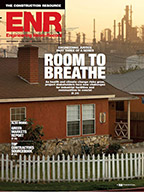Roadwork
The transportation market has been struggling for a couple of years. The passage of the Moving Ahead for Progress in the 21st Century Act (MAP-21) legislation has provided some stability for state DOTs to plan longer-term projects, but many contractors say this is just a patch on what is really needed from Congress.
The irony of the market is that there are many enormous transportation projects across the country but few smaller jobs. "As I travel around the country, I do not see the smaller, bread-and-butter projects that keep regional contractors and pavers busy," says Levy.
Many contractors see public-private-partnerships (P3s) and other alternate funding mechanisms as a means to fill the gap left by MAP-21 and local budget shortfalls. For example, the $1.5-billion Goethels Bridge replacement project in New Jersey is a P3 job. Further, the federal Transportation Infrastructure Finance and Innovation Act authorizes credit assistance for alternative project financing.
Some contractors have been actively seeking out P3 opportunities. "We are seeing that large transportation projects using the P3 delivery system are gaining momentum, and we will use our expertise in this area to look to capture those opportunities," says Shaun Yancey, executive vice president, PCL Construction Enterprises. He says PCL is creating strategic alliances with consultants and contractors to pursue these jobs.
One of the difficulties in the increased use of P3s is that American investors are not used to this sort of investment. However, Canadian and European contractors have long used this type of financing for infrastructure. "The influx of foreign players is changing the market. They have unlimited access to capital as they are backed by their countries. That's something we don't have here in the U.S. It is not always a level playing field," says Robert Alger, CEO of the Lane Construction Corp.
One transportation market that has not had to scramble for funds is private railroads. "The large, Class 1 railroads have been listening to their customers and investing heavily to meet their needs," says Levy. To upgrade their infrastructure, railroads have been investing $10 billion to $12 billion a year for several years and will spend $13 billion this year, he says. "The problem is that it is a good market, so we are seeing new competitors, like highway contractors, trying to get into it," Levy says.
The Cost of Health-Care on Firms
The health-care market has been in flux as a result of the Patient Protection and Affordable Care Act and the uncertainty of its effect on health-care providers. However, contractors of all types, regardless of what market they serve, have their own concerns about the new health-care law.






Post a comment to this article
Report Abusive Comment